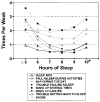Sleep Complaints of Postmenopausal Women
- PMID: 21461131
- PMCID: PMC3068046
- DOI: 10.1053/cjwh.2001.30491
Sleep Complaints of Postmenopausal Women
Abstract
OBJECTIVE: To study correlates of sleep problems in postmenopausal women. METHODS: Baseline questionnaire items related to sleep patterns and problems were administered to 98,705 postmenopausal women as part of the Clinical Trial and the Observational Study of the Women's Health Initiative. RESULTS: Less than 27% of the sample reported sleeping 8 hours or more. Many women reported that at least once a week they awoke several times at night (61%), fell asleep during quiet activities (52%), or reported other symptoms suggestive of insomnia or excessive daytime sleepiness. More frequent insomnia problems were reported among women who reported nocturnal sleep longer than the mode of 7 hours, as well as among women who reported very short sleep. Age, ethnicity, hormone replacement therapy, employment, marital status, diet, and season explained remarkably little of the variance in sleep duration or insomnia complaints; however, black women reported sleeping 0.45 hours on average less than whites, with the other minorities being intermediate between these groups. CONCLUSIONS: The results suggest that simple abbreviation of sleep and demographic factors may be less important in the sleep complaints of postmenopausal women than other possible factors. Cognitive-behavioral processes, depression, and obesity with apnea may be among the causes.
Figures




References
-
- Karacan I, Thornby JI, Anch M, et al. Prevalence of sleep disturbance in a primarily urban Florida county. Soc Sci Med. 1976;10:239–44. - PubMed
-
- Bixler EO, Kales A, Soldatos CR, et al. Prevalence of sleep disorders in the Los Angeles metropolitan area. Am J Psychiatry. 1979;136:1257–1262. - PubMed
-
- Cirignotta F, Mondini S, Zucconi M, et al. Insomnia: An epidemiological survey. Clin Neuropharmacol. 1985;8(suppl 1):S49–S54. - PubMed
-
- Ford DE, Kamerow DB. Epidemiologic study of sleep disturbances and psychiatric disorders: An opportunity for prevention? JAMA. 1989;262:1479–1484. - PubMed
-
- Kripke DF, Simons RN, Garfinkel L, Hammond EC. Short and long sleep and sleeping pills: Is increased mortality associated? Arch Gen Psychiatry. 1979;36:103–116. - PubMed
Grants and funding
LinkOut - more resources
Full Text Sources
Medical
